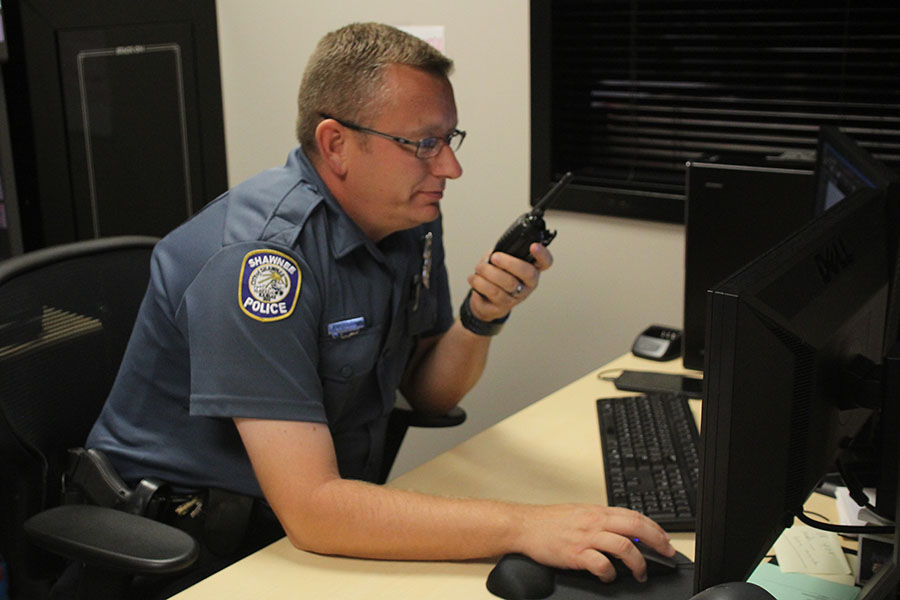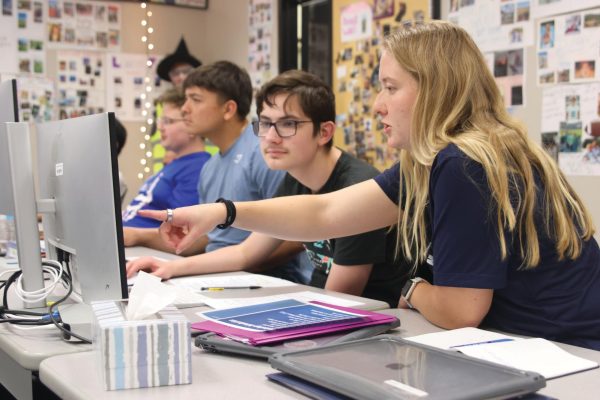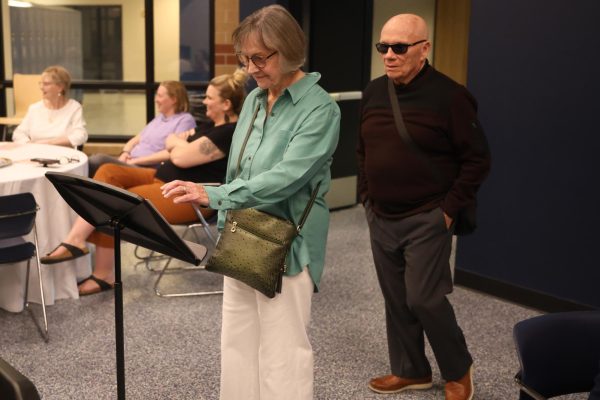New intruder plan created after Newtown shooting
District activates proactive procedure for intruder situations
By Jack Lopez
Speaking to an administrator through his radio, school resource officer Mo Loridon watches surveillance video on Friday, Sept. 20. “Preparation is literally just all about education,” Loridon said. “I now have to re-educate teachers and staff members on how to survive if something like that happens.”
The school district has initiated a new intruder procedure after the school shooting in Newtown, Conn. last December sparked discussion over how the district could improve its preparations for intruders.
As a result, ALICE (Alert, Lock-down, Inform, Counter, Evacuate) training will be provided to district staff by school resource officer Mo Loridon and Mill Creek Middle School SRO Danny Chavez, who have received this training. In the past, intruder drills have required that students and staff hide from intruders, but the new procedure allows for more flexibility in decision-making by staff members during a crisis.
ALICE was created by former SWAT officer Greg Crane and his wife in the mid-2000s when he realized that hiding during an intruder situation made students and staff easier targets and took away the opportunity to defend themselves.
“[ALICE] is a philosophy that we try to give teachers and students of how to react in a situation,” Loridon said. “You don’t have to follow the acronym [every letter] in a row, but it just gives you different ways of thinking in a crisis situation – alert people, lock the doors, tell somebody about it. If you can get out, get out. If you can’t get out, counterattack.”
District director of administrative services and community relations Alvie Cater said ALICE is intended to provide multiple ways for staff members to handle a crisis situation.
“One of the things we want our staff to know during a crisis is that they have options,” Cater said. “What we’re saying is don’t sit there and take it. If you have an option to escape, then take it. But you have the chance to fight back. Also, if you’re slowing the intruder down, you’re saving lives.”
According to Cater, the district wanted to make sure that it was doing everything it could to keep students and staff prepared for any intruder situation.
“There is nothing we can do to prevent a tragedy like Sandy Hook, but what we can do is prepare,” Cater said. “As a team, we want to make sure we are taking steps to improve the safety and security we have while still keeping our schools welcoming, so that’s the balance we’re trying to find.”
Loridon said that students need to stay calm and follow their teacher’s instructions during any situation.
“The first thing they have to do is be quiet,” Loridon said. “You have to be quiet, you have to listen to your teacher. If everybody freaks out and starts screaming, it just causes more chaos. I want students to have the chance to survive.”
English teacher Dorothy Swafford likes the changes.
“[I like it] because it gives us a plan of attack instead of [being] sitting ducks,” Swafford said. “It allows us the chance to protect ourselves and others and save others.”
Sophomore Katie Burke thinks a more proactive intruder policy was a needed change.
“[I think it was necessary] because doing something about it is better than just being harmed and doing nothing,” Burke said. [I like the new procedure better] because it’s more effective than just sitting there. The concept of it is uncomfortable, but knowing what to do makes me feel better.”
Junior Maddy Loving, however, does not think a change was needed, but she also believes the new procedure will be more effective.
“I think we would have been fine with the old procedures, but if we were to have an intruder, the new procedure would work better,” Loving said. “I don’t [think it’s a serious issue at Mill Valley] because I don’t think it’s very likely we’d ever have an intruder, but I’m glad we’re prepared.”
In regards to students, Cater believes that it is important to pay attention to and report any signs of a possible situation.
“The thing I’ve learned is that you have to look for signs,” Cater said. “If you look back at the history, there might have been that flag there.”
Loridon agrees.
“We’re working on teachers understanding language and seeing signs better, so if a kid’s talking about negative things or talking about hurting themselves or hurting others, [they need] to report it instead of just trying to handle it themselves,” Loridon said.
Loridon now believes that changing mindsets about intruder situations is the best way for students and staff members to prepare“Preparation is literally just all about education,” Loridon said. “I now have to re-educate teachers and staff members on how to survive if something like that happens. That’s changing the mindset.”

Senior Jack Lopez is in his third and final year on the newspaper staff. After being a reporter one year and the opinions editor the second, he will be the managing and copy editor for the 2013-2014 publication. When he isn't in the journalism room, Jack is usually playing soccer, making music or working. One of his favorite quotes is "Be soft. Do not let the world make you hard. Do not let pain make you hate. Do not let the bitterness steal your...













